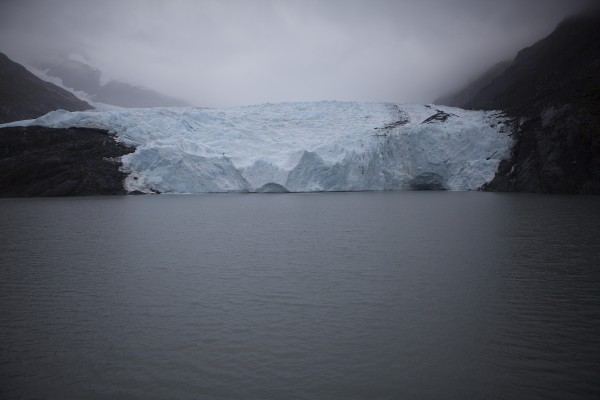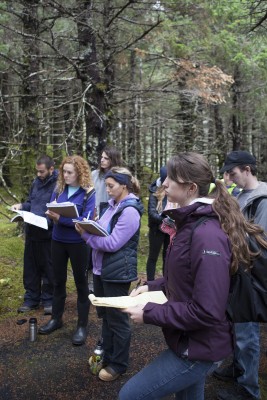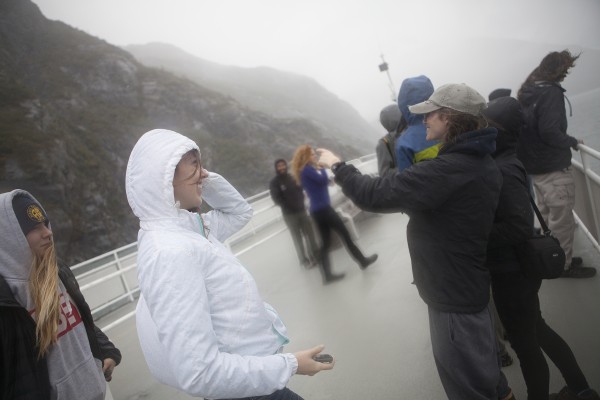Portage Glacier's rapid retreat
by J. Besl |

Students studied the retreat of Portage Glacier on a recent Saturday afternoon boat tour across Portage Lake. (Photo by Philip Hall / University of Alaska Anchorage)
This is the third in a three-week series covering Anchorage Field Studies, a UAA geology class taught by Dr. Kristine Crossen.
Although most of the students in Anchorage Field Studies are born-and-raised Alaskans, few had ever seen Portage Glacier. "I'm a bad Alaskan. I had never been out there before," laughed senior Alex Busk. After all, the boat tour is for tourists. Right?

Professor Kristine Crossen talks with Mark Turner on the trip across Portage Lake. (Photo by Philip Hall / University of Alaska Anchorage)
In geology — where things are measured in millennia — Portage Lake is barely a blink in Alaska's existence. The lake first appeared only in 1914 and, in the century since, it's rapidly retreated five miles towards the mountains. Outside the visitor's center, Professor Kristine Crossen explained to her students the ways they could determine the furthest reach of the glacier, as well as the year of its apex. She also explained the massive melting was not, in fact, due to epic warming. Rather, the glacier's recent retreat is a result of the lake, and the lake is result of the glacier. Confused? Read on. Portage Lake, it turns out, is much more than a spot for #glacierselfies.
Global warming, local evidence
Before boarding the buses, Kris welcomed her class with a Saturday morning PowerPoint on recent climate history. Though change is certainly in the air, the planet has always slipped in and out of cold spells and heat waves. For the past thousands of years, the earth has loosely followed a 500-year cycle of warming and cooling, marked most recently by the Medieval Warm Period (950 to 1250 A.D.) and the Little Ice Age (1300 to 1850 A.D.).
Evidence of both periods is readily spotted in written historical records-a rare resource for geologists. During the peak of the Warm Period, southern England was noted for its vineyards while Vatican tax records show farmlands stretching north. Then things got colder. The Little Ice Age is visible everywhere from frozen rivers in 17th century Dutch paintings to archaeological digs at abandoned Greenlandic settlements to newspaper coverage of winter carnivals held on the frozen sea ice in Boston Harbor. Chinese astronomers recorded sunspots in a solar output calendar, while massive volcanic eruptions in Indonesia, Iceland and elsewhere choked sunlight for years.
Climate is both affected and evidenced in locations around the world. Where, then, is the supporting evidence of climate change here in Southcentral Alaska? Just take a look at Portage Lake.

in 1852, Portage Glacier advanced to the edge of present-day Portage Lake before retreating towards the Chugach Mountains. (Photo by Philip Hall / University of Alaska Anchorage)
From about 1500 to 1800, every glacier in the region was advancing, adding more mass at the top than it lost at its terminus. At the beginning of last century, Portage Lake didn't even exist. In 1900, travelers would just strap on cleats, tack ice spikes to the hooves of their mule teams and hike the glacier over Portage Pass into Whittier, no boat necessary.
That all changed in 1914, when the northwest corner of Portage Lake emerged. Even though the lake is now five miles long and a half-mile wide, it's barely 100 years old. Back when Woodrow Wilson was in the White House and World War I began in Europe, Portage Glacier boasted 800 feet of vertical ice with bergs the size of the downtown Marriott regularly slicing off the top and plunging toward the earth.
My how the times have changed.
Taking a lichen

Students learn about tree coring and dendrochronolgy on the Moraine Trail outside the Begich-Boggs Visitor's Center. (Photo by Philip Hall / University of Alaska Anchorage)
Anyone who's visited the Begich-Boggs Visitor's Center in Portage has stood at the farthest recent advance of the glacier. As the glacier carved out the valley, it bulldozed the forests and stacked a pile of debris ahead of it, creating a natural dam that became the lake's northern edge.
This wall of debris is called a moraine, and Portage's Moraine Trail — a mossy ridge lined with young trees — weaves through the landform. "[The glacier] pushed up this big pile of till, and when it started to melt, the melt water got caught behind the till," said geology major Phil De Land.
"Moraines basically track what was happening with the climate," noted Alex. After the glacier left, life returned to the moraine. The most common windows into the past are tree rings and lichens, both of which expand annually. Thanks to the Turnagain Arm's perfect conditions — low elevation, tons of rain and a temperate climate — the lichens along the Moraine Trail are the fastest growing in the world. Through dendrochronology (counting tree rings) and lichenometry (measuring lichens), geologists have agreed that Portage Glacier built up the moraine by 1852 before starting its current retreat.
But the glacier is now several miles from the Moraine Trail. How did it retreat so far, so quickly? It all has to do with the lake.

Kris teaches about the time-telling tools provided by lichen specimens along the Moraine Trail. (Photo by Philip Hall / University of Alaska Anchorage)
Rapid retreat
It turns out depth of water drastically affects the rate of calving. Like ice in a glass of lemonade, glaciers also aim to float. So even though Portage Lake is 600 feet at its deepest, all that underwater ice naturally pushed toward the surface. The dramatic calving on the surface is nothing compared to the terrifying shooters below-the massive chunks of buoyant ice that rocket from the depths and explode onto the surface.

Students snap photos as the boat tour lingered alongside Portage Glacier. (Photo by Philip Hall / University of Alaska Anchorage)
Phil grew up in Anchorage, and had his parents' perspective to lean on. "My mom has photos from 30 years ago when the ice was still retreating, but I didn't realize it had gone back that far in just a few years," he said. "That's what's causing it to calve, the water is tearing big hunks of ice off."
It's easy to assume that global warming caused the extreme retreat of Portage Glacier, but the depth of the water overrules any climatic action. The more of the ice face that sits in the water, the faster the glacier will calve, which in turn leads to a faster retreat.

Portage Glacier's retreat has slowed significantly since reaching the far shore of Portage Lake, evidencing the significant impact water has on a glacier's retreat. (Photo by Philip Hall / University of Alaska Anchorage)
Need evidence? Consider that in the entire 19th century — including 1852, when the glacier reached the present-day Moraine Trail — the glacier retreated an average of five meters per year. In the entire 20th century — including the 1914 emergence of Portage Lake — it blitzed backwards 55 meters per year-a larger than tenfold increase. In 1994, the glacier reached land on the other side of the lake and the retreat slowed significantly yet again.
"In 1994 it hit this bedrock. It stopped calving and it's been there ever since," Alex noted. "It's still thinning and it's still retreating, but there are different drivers on a how a glacier retreats."
"That catastrophic retreat is definitely from a climatic swing, but now the glacier has hardly moved since it hit the shore," Phil added. "Sometimes just small fluctuations can cause a series of events that really takes off."

Students crowd the deck on a wet weekend boat tour across Portage Lake. (Photo by Philip Hall / University of Alaska Anchorage)
"We're like their kids"
As the boat set off toward Portage Glacier, students threw on their rain jackets, climbed the stairs, brushed mist off their camera lenses and jotted observations in their windswept clipboards.

Geology senior Alex Busk shoots a photo on Portage Lake for her weekly report. (Photo by Philip Hall / University of Alaska Anchorage)
Like trees and lichens, the ice also records climatic history. Darker lines indicate years of greater melting, lighter layers are bubbles trapped in the ice. The thick line of gray grit along the top is a lateral moraine, a pile of debris pushed onto the surface from Bard Glacier as it descended a nearby valley before it, too, retreated.
"If you sit in a classroom and they tell you this, you can imagine it but it's not like you're there," Alex said of the Anchorage Field Studies class. "Seeing the size of these events and putting it all together is, I think, the most beneficial thing."
For Alex — who had never even left the state until a geology trip through the American Southwest last year — the class has been an eye-opening recognition of the geology hub she calls home.
"It's really nice for me because I'm a senior, so everything Kris says is consolidating everything I know," she noted. "And on top of that, she doesn't only lecture in the morning about the big overview. I actually get to go see it. This class is really valuable to me because when I take field camp — the initiation to becoming a geologist — I'll be able to see this and interpret it."
Alex is energized about a lot of things, but she has a special affinity for the geology department at UAA.
"Everyone is super amazing. They're really knowledgeable and really helpful. We're like their kids," she said of the department, where students are on first-name basis with their professors.
"It's an amazing field, it's an amazing subject, and we have the best department with the best professors."

Bard Glacier deposited a lateral moraine, visible in the upper right, onto Portage Glacier before it, too, retreated. (Photo by Philip Hall / University of Alaska Anchorage)
For more on Anchorage Field Studies, read about the field trip to Bird Point and the tour of the Girdwood ghost forest.
Written by J. Besl, UAA Office of University Advancement
 "Portage Glacier's rapid retreat" is licensed under a Creative Commons Attribution-NonCommercial 4.0 International License.
"Portage Glacier's rapid retreat" is licensed under a Creative Commons Attribution-NonCommercial 4.0 International License.














